













|
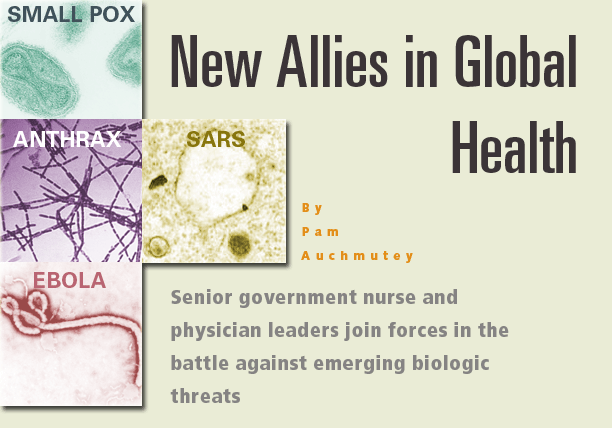 |
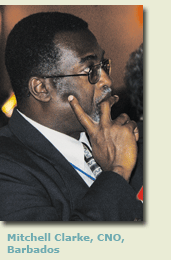 |
 or
two days straight, Dr. Alimjan Koshmuratov listened intently as
nursing, medical, and public health leaders from around the world
described their frontline battles against SARS, Ebola virus, anthrax,
smallpox, influenza, West Nile virus, and HIV/AIDS. “There
is no peace time or war time,” concluded Koshmuratov, the
chief medical officer for Kyrgyzstan. “For nurses and doctors,
every day is a battle.” or
two days straight, Dr. Alimjan Koshmuratov listened intently as
nursing, medical, and public health leaders from around the world
described their frontline battles against SARS, Ebola virus, anthrax,
smallpox, influenza, West Nile virus, and HIV/AIDS. “There
is no peace time or war time,” concluded Koshmuratov, the
chief medical officer for Kyrgyzstan. “For nurses and doctors,
every day is a battle.”
No one attending the historic conference
hosted by the Nell Hodgson Woodruff School of Nursing would argue
with his sentiment. In a time when emerging biological threats—intended
and natural—honor no boundaries within or among nations, the
need for collaborative partnerships and critical care from nurses,
physicians, and public health experts is acute.
Last June, 160 health leaders from
70 nations convened in Atlanta for the 2004 Global Government Health
Partners Leadership Forum. Chief nursing officers (CNOs), chief
medical officers (CMOs), and ministers of health came together for
groundbreaking sessions with experts from the World Health Organization
(WHO), the Centers for Disease Control and Prevention (CDC), the
Commonwealth Health Ministers Steering Committee for Nursing and
Midwifery, The Carter Center, Emory University, and other major
organizations and countries. Organized by the Lillian Carter
Center for International Nursing in the School of Nursing, the forum
focused worldwide attention on the critical roles that government
health leaders play in preventing, identifying, and managing biological
threats.
Armed with new ideas and information,
health leaders put their heads together to develop country-specific
plans to help prevent and contain biological threats at home. The
Lillian Carter Center is following up on implementation of those
plans.
In the eyes of health experts, the
forum was an important step “in starting to build bridges
between chief medical officers and chief nursing officers, crossing
a professional divide that has posed a barrier to collaboration
for many, many years,” said Dr. Mark Rosenberg, executive
director of the Task Force for Child Survival and Development and
a faculty member in the Rollins School of Public Health. “It
is important to work together because time and resources are in
short supply, and there is so much that could be and should be done.”
During the forum, plenary and panel
speakers talked candidly about managing recent crises that have
stretched health care workers and systems to their limits. In the
face of these challenges, health leaders must be ever more vigilant
in protecting their own country populations as well as those half
a world away.
“Partnerships between government
medical and nursing leaders are critical,” noted Dr. Marla
Salmon, dean of the nursing school and director of the Lillian Carter
Center. “This was the second international nursing conference
we have hosted at Emory to help meet an urgent need for coordination,
collaboration, and shared information among global leaders within
and across country lines.”
“Threats like SARS or new strains
of influenza travel quickly across national borders and demand quick,
coordinated response from health care leaders globally,” added
Dr. Jeffrey Koplan, vice president for academic health affairs in
Emory’s Woodruff Health Sciences Center and conference co-chair
with Salmon. “It is vitally important to have leaders who
know and trust their colleagues and who have thought deeply about
therequired responses ahead of time.” |
 |
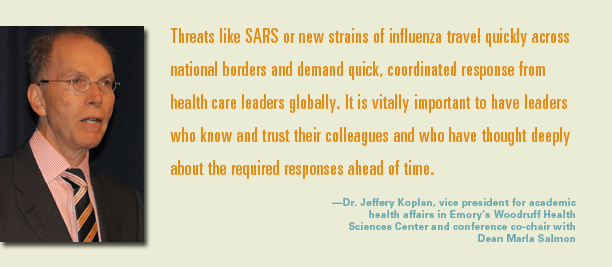 |
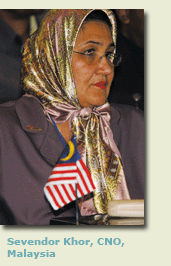 |
The
forum built on the success of the first global health partners meeting
involving CNOs from more than 60 countries intent on developing
their leadership skills and building bridges with one another to
address common nursing workforce issues. The 2001 conference set
a precedent by bringing CNOs, national nursing association leaders,
and government human resource planners together globally for the
first time.
Likewise, the 2004 forum was a first
for CNOs, CMOs, and ministers of health worldwide. CNO Ruti Nubi
and CMO Ratna Hendardji traveled the furthest distance—more
than 10,000 miles—to learn how they could better protect the
health of fellow citizens in Indonesia.
Nubi and Hendardji are among the many
leaders Emory President James Wagner had in mind when he coined
the phrase “destination university” after taking office
over a year ago.
“Universities can provide a
context in which disciplines are expected to engage in creative
and positive transformations not otherwise possible,” Wagner
said during the forum. “Emory in particular is a special resource
to the world. We are committed to living this out in ways that really
make a difference. We hope there will be a long-term benefit in
strengthening partnerships here to improve health for all peoples
of all countries.”
The Carter Center made for an appropriate
meeting site since its work to improve health and eradicate disease
is rooted in partnerships with Emory, other organizations, and various
countries. “The aspects that you’ve applied in your
discussions carry over into many other aspects of health,”
Dr. John Hardman, executive director of The Carter Center, told
participants. “Accurate and timely information is critical
to working not only with colleagues in your own countries but those
around the world.” |
 |
| |
|
|
| |
A
CLARION CALL
 he
2004 global forum provided a wealth of information that was timely,
practical, inspiring, and sometimes frightening. When Dr. Jack Chow,
WHO assistant director, took the podium, he issued a clarion call
for concerted action against HIV/AIDS, tuberculosis, and malaria,
which claim a total of 6 million lives each year. “The annual
death toll rivals the combat casualty rate of World War II globally,”
said Chow, who leads WHO’s efforts on all three fronts. he
2004 global forum provided a wealth of information that was timely,
practical, inspiring, and sometimes frightening. When Dr. Jack Chow,
WHO assistant director, took the podium, he issued a clarion call
for concerted action against HIV/AIDS, tuberculosis, and malaria,
which claim a total of 6 million lives each year. “The annual
death toll rivals the combat casualty rate of World War II globally,”
said Chow, who leads WHO’s efforts on all three fronts.
His arsenal includes the “3
by 5 Initiative” to treat 3 million people with HIV/AIDS by
the end of 2005. Through this plan, WHO is working to simplify and
standardize drug treatment and train 100,000 community health workers—including
nurses—in the safe delivery of antiretroviral therapy. Also,
WHO is studying the coexistence of HIV and tuberculosis, examining
bacterial resistance to TB treatments, and reducing costs and improving
distribution of insecticide-treated bed nets for malaria.
“You are among the health leaders
leading the charge to liberate the world from these three diseases,”
Chow told the attendees. “We can liberate generations of people
who can live their lives productively and joyfully. We can keep
parents alive for their children, children alive for their futures,
and nations alive for their destinies. Fellow doctors and nurses,
there is no more compelling mission that we can embark on together.”
|
 |
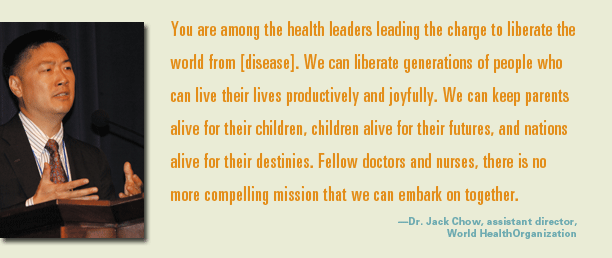 |
| |
SMALL
WORLD NETWORKS
 ike
Chow, Dr. Julie Gerberding is familiar with the devastating effects
of AIDS. An infectious disease expert, she worked in the eye of
the AIDS storm in San Francisco during the 1980s and now monitors
numerous storms daily as director of the CDC. ike
Chow, Dr. Julie Gerberding is familiar with the devastating effects
of AIDS. An infectious disease expert, she worked in the eye of
the AIDS storm in San Francisco during the 1980s and now monitors
numerous storms daily as director of the CDC.
“Anthrax, West Nile virus, smallpox
vaccinations, monkey pox, flu season, mad cow disease, avian influenza—all
show what a small world it is and teach us how connected we are,”
said Gerberding.
Consequently, health experts now
view infectious diseases as “small world networks” to
understand how they emerge and spread. In 2003, SARS traveled from
a remote site in China, where highly clustered transmission patterns
spread the disease quickly. Soon, new cluster patterns extended
from Hong Kong to other parts of Asia and even Canada. Similarly,
in fall 2001, postal processing centers became perfect “small
world networks” for transmitting anthrax-tainted mail in the
United States.
Today, the CDC is evolving continuously
to deal with such phenomena. “We’re seeking input to
work together in a small world,” said Gerberding. “We
hope this will make us better partners to do what we do better.”
Greater preparedness for responding
to biological threats is a top priority. “We have to reach
out and ensure knowledge gets out quickly so that we’re all
on the same page,” Gerberding said. “It’s important
to be first, be right, and be credible, including acknowledging
what you don’t know.”
Whatever the emergency, health workers
must serve first and foremost as patient advocates. “We need
to put caring back in health care so we can revel in the honor and
joy that caring for patients can bring,” Gerberding said.
“If we touch a patient—once a month, once a week, or
once a day—that is really the strongest link in our small
world.” |
 |
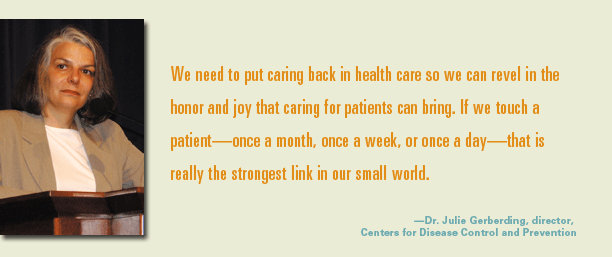 |
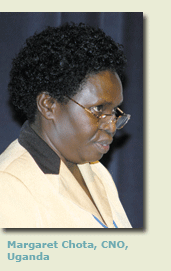 |
LIVES
ON THE LINE
 roviding
care and comfort to patients in a small world can be risky, plunging
health care systems into crisis. Dr. Denzil Douglas, prime minister
of St. Kitts and Nevis, worries about filling the void left by the
900 nurses who left the Caribbean in 2002-2003 to work in North
America and Europe. Many left for fear of contracting AIDS from
patients. In 2000, Minister of Health Jim Muhwezi and others fought
valiantly to stop the deadly Ebola virus that killed 17 health care
workers in Uganda. In 2003, SARS claimed more than 750 lives worldwide,
including the Italian doctor who roviding
care and comfort to patients in a small world can be risky, plunging
health care systems into crisis. Dr. Denzil Douglas, prime minister
of St. Kitts and Nevis, worries about filling the void left by the
900 nurses who left the Caribbean in 2002-2003 to work in North
America and Europe. Many left for fear of contracting AIDS from
patients. In 2000, Minister of Health Jim Muhwezi and others fought
valiantly to stop the deadly Ebola virus that killed 17 health care
workers in Uganda. In 2003, SARS claimed more than 750 lives worldwide,
including the Italian doctor who
first detected the virus in Vietnam. “I’ve never seen
greater levels of stress on nurses and doctors than with this outbreak,”
said Dr. Keiji Fukuda, lead epidemiologist with the influenza branch
of the CDC, of SARS.
In China, Dr. Zonghan Zhu monitored
the outbreak as a member of a national research committee and head
of an expert control group for Beijing. When news about SARS became
public, China was criticized widely for responding slowly to the
virus. But as Zhu noted, identifying patients with SARS was difficult
at first since the disease had never existed.
“China did not believe it was
going to be a problem for the rest of the world,” said Dr.
Alison McGeer, a Canadian physician who wrestled with SARS in Toronto.
“Underrestimating the problem is an idea we can all be trapped
in. We need to make sure that when we are transparent we don’t
get punished for it.”
In Toronto and in Asia, nurses and
doctors faced tremendous uncertainty and danger. “Nurses were
essential to providing clinical and psychiatric care,” said
Zhu. “This was the most important measure in the treatment
of SARS patients because no visitors were allowed.” |
 |
| |
|
|
| |
A
NEW WORLD ORDER
 hile
those who care for the sick have battled global infections for centuries,
changing social patterns are reshaping the ways in which health
experts respond. The factors are numerous: International travel.
Global commerce and food supplies. Populations migrating from rural
to urban areas. More frequent contact between people and animals.
More densely populated cities. Increasing numbers of elderly people
suffering from chronic conditions. Bacteria-resistant antibiotics.
All point to the need for greater global collaboration to prevent
and contain disease. hile
those who care for the sick have battled global infections for centuries,
changing social patterns are reshaping the ways in which health
experts respond. The factors are numerous: International travel.
Global commerce and food supplies. Populations migrating from rural
to urban areas. More frequent contact between people and animals.
More densely populated cities. Increasing numbers of elderly people
suffering from chronic conditions. Bacteria-resistant antibiotics.
All point to the need for greater global collaboration to prevent
and contain disease.
At the CDC, Fukuda keeps a constant
eye on bird flu. Of particular concern is avian influenza A (H5N1),
a virus strain that infected people with “unusual lethality”
in Hong Kong in 1997. The outbreak proved the virus could spread
from birds to people. Since then, outbreaks among poultry have escalated
in Asia and very recently among cats and zoo tigers.
“Flu is a leading candidate
for an epidemic or pandemic,” Fukuda warned. “The timing
and severity are unpredictable. H5N1 is most feared because it is
very hard to control in Asia.”
In response, governments are focusing
on surveillance and information sharing, culling and vaccination
of birds, vaccine development, coordination of international financial
and technical assistance, and greater preparedness.
“Early detection and response
are by far the most effective ways to reduce deaths,” Fukuda
told participants who asked how countries with fewer resources could
guard against diseases like SARS. He also encouraged them to revisit
their preparedness plans and seek assistance from outside agencies
like the US Department of Health and Human Services, which has set
aside $5 billion to help developing countries strengthen their surveillance
systems.
“I would urge all of you to
take advantage of that,” Fukuda said. “These windows
of opportunity are not open all the time.” |
 |
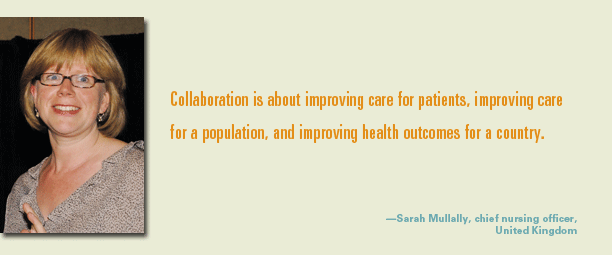 |
 |
PARTNERS
IN PREPAREDNESS
 any
countries have stepped up plans for biohazard and bioterrorism preparedness.
In the United Kingdom, nurse and physician leaders developed a government
plan on the heels of a strategy implemented in the past five years
to empower nurses as equal partners in the medical profession. “We
know it’s not possible to become equal partners (with physicians)
without a strategy in place,” said Sarah Mullally, then CNO
of the United Kingdom. “Collaboration is about improving care
for patients, improving care for a population, and improving health
outcomes for a country.” any
countries have stepped up plans for biohazard and bioterrorism preparedness.
In the United Kingdom, nurse and physician leaders developed a government
plan on the heels of a strategy implemented in the past five years
to empower nurses as equal partners in the medical profession. “We
know it’s not possible to become equal partners (with physicians)
without a strategy in place,” said Sarah Mullally, then CNO
of the United Kingdom. “Collaboration is about improving care
for patients, improving care for a population, and improving health
outcomes for a country.”
Following 9/11, UK health leaders
formed a new national agency dedicated to chemical, radiation, and
environmental threats as well as communicable disease. Among other
measures, the health protection workforce now includes a new cadre
of community-based infectious disease control nurses prepared to
play key roles across England. “Nurses are helping in confronting
the hazards that face us,” said Gabriel Scully, regional director
of public health for southwestern England.
Working together, nurses and physicians
have put new guidelines in place for swift and early response to
smallpox. Teams of doctors, nurses, and others stand ready to staff
vaccination centers within 48 hours of the first reported case.
“Close collaboration of nursing and medical leaders is vital
if we have to put measures in place that we very well may need,”
said Scully.
MODELS
FOR THE WORLD
 n
Uganda, collaboration was key during the fall 2000 Ebola virus outbreak,
recalled Margaret Chota, the nation’s CNO. Once the virus
was identified, WHO and CDC teams rallied immediately to assist
nurses and doctors. Local medical staff members were trained quickly
in surveillance and personal protection, invasive surgery was halted,
and mobile teams learned precautions for transporting suspected
cases and burying bodies to prevent transmission. Doctors and nurses
followed WHO/CDC guidelines for isolating cases. Their efforts rid
Uganda of the disease by February 2001. n
Uganda, collaboration was key during the fall 2000 Ebola virus outbreak,
recalled Margaret Chota, the nation’s CNO. Once the virus
was identified, WHO and CDC teams rallied immediately to assist
nurses and doctors. Local medical staff members were trained quickly
in surveillance and personal protection, invasive surgery was halted,
and mobile teams learned precautions for transporting suspected
cases and burying bodies to prevent transmission. Doctors and nurses
followed WHO/CDC guidelines for isolating cases. Their efforts rid
Uganda of the disease by February 2001.
“It’s hard to imagine
the courage it takes to work in a setting like that,” observed
forum co-chair Dr. Jeffrey Koplan, who spent time on the ground
with nurses and doctors during the Ebola outbreak. “They were
models for the rest of the world.”
In Jamaica, government leaders there
are changing attitudes about HIV/AIDS. By combining forces, national
and local health leaders have reduced fear about disease transmission
and discouraged risky behavior. Men and women hold new posts as
containment investigators, who play a pivotal role in surveillance.
Peer educators work among prostitutes and inner-city residents to
spread the word about prevention and treatment.
“Families now care, and condom
use is up,” said Thelma Campbell, CNO of Jamaica. “These
approaches would not have worked without multisectional support
and partnerships.”
Much more remains to be done—funding
a vaccine trial, enforcing policies and laws to halt discrimination,
and improving care for people with the disease.
“The time to act is now,”
said Barrington Wint, CMO for Jamaica. “If not us, who? If
not now, when?”
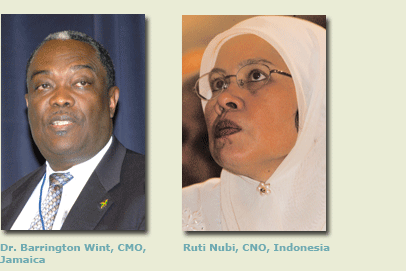
|
|
 |
| |
|
|
 |

 hat
do a Scottish bagpiper, an African drummer, and a Caribbean steel
drum trio have in common? All represent the regions of three individuals
who received the 2004 Global Health Leadership Awards from the Lillian
Carter Center for International Nursing. The musicians performed
during a festive dinner sponsored by GE Energy and GE Healthcare
Technologies. hat
do a Scottish bagpiper, an African drummer, and a Caribbean steel
drum trio have in common? All represent the regions of three individuals
who received the 2004 Global Health Leadership Awards from the Lillian
Carter Center for International Nursing. The musicians performed
during a festive dinner sponsored by GE Energy and GE Healthcare
Technologies.
As Dr. Holli Semetko, Emory vice provost
for international affairs, noted, all of the guests had traveled
long distances to Atlanta in the spirit of international cooperation.
“The kinds of health issues you are grappling with are fundamentally
important,” she said.
Among those honored was Sir George
Alleyne, a national from Barbados dedicated to improving health
throughout the Caribbean. Alleyne directed the Pan American Health
Organization from 1995 to 2003 and currently serves as chancellor
of the University of the West Indies. He also leads a Caribbean
Community commission charged with examining health issues confronting
the region and their impact on national economies.
Now retired, Anne Jarvie served as
chief nursing officer for Scotland and director of nursing for its
health department since 1992. Jarvie played a major role in increasing
the number of nursing students and elevating nursing research. She
also led the development of “Caring for Scotland,” a
landmark strategy for nursing and midwifery, and “Nursing
for Health,” a review of the contributions that nurses and
midwives make to the public’s health. Both were launched in
2001.
The Lillian Carter Center also paid
tribute to Janet Museveni, first lady of Uganda, for her efforts
to improve care for vulnerable people with HIV/AIDS. Additionally,
Museveni has worked to improve the health and well-being of children,
including those orphaned by HIV/AIDS, and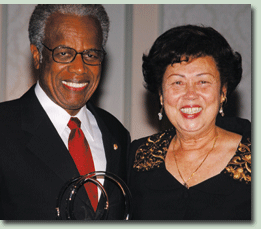 supported rural women’s groups and women at risk of violence
and other forms of abuse. Brigadier Jim Muhwezi, Uganda’s
minister of health, accepted the Global Health Leadership Award
on her behalf.
supported rural women’s groups and women at risk of violence
and other forms of abuse. Brigadier Jim Muhwezi, Uganda’s
minister of health, accepted the Global Health Leadership Award
on her behalf. |
 |
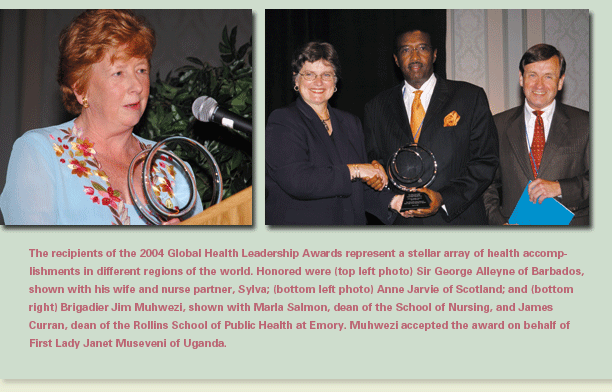 |
| |
|
|
|
|
|